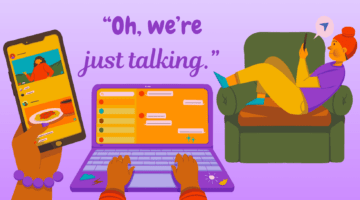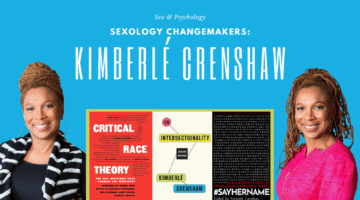What I Learned From a Decade of Studying Friends With Benefits
August 25, 2021 by Justin Lehmiller
The very first sex study that I ever published appeared in the Journal of Sex Research in 2011, and it explored similarities and differences in how men and women approach friends with benefits (FWBs). In the decade since, I’ve co-authored a total of four journal articles on the subject plus one book chapter and 10 conference presentations. Along the way, I’ve learned a lot! In this post, I’ll share some of the key things I discovered through this work.
On Average, Men and Women Want Different Things in FWBs
In the 2011 study mentioned above, we surveyed 411 adults, all of whom said they currently had at least one FWB [1]. Participants ranged in age from 18 to 65 and most (86%) were heterosexual. Everyone was asked what they hoped would come of their FWB arrangement in the future, which could mean staying FWBs long-term, becoming romantic partners, becoming friends only, or having no relationship of any kind.
It turned out that men and women provided very different answers to this question. While the vast majority of women (69%) wanted their relationship to change in some way, the majority of men (60%) wanted to keep things the same. In other words, women were more likely to see their FWBs as a temporary state, whereas men were more likely to see their FWBs as an end state.
In what way(s) did women want their FWB to change? Women (compared to men) were more likely to hope that they would become a romantic couple (43% vs. 24%, respectively). Women were also more likely than men to hope that they would eventually go back to being just friends (20% vs. 10%, respectively).
The Sexual Behaviors of FWBs and Romantic Partners Differ in Several Ways
In a conference presentation I gave at the Society for the Scientific Study of Sexuality, I discussed results from a survey of approximately 1,100 adults who either had a current friend with benefits (26%) or romantic partner (74%) [2]. Participants were 29 years old on average and most identified as heterosexual (74%).
Everyone was asked to indicate whether they had engaged in a variety of specific sexual practices with their partner, from vanilla to kink.
When comparing across relationship type, one of the differences that emerged was that romantic partners were more likely to kiss one another than FWBs, although this difference was quite small. However, larger differences were observed for kink and multi-partner activities.
FWBs were about twice as likely to have had a threesome, while romantic partners were 50% more likely to have tried bondage. Why is that? It may be because BDSM desires are more likely to be shared and acted upon in relationships characterized by high levels of sexual communication, like romances (and, indeed, in some of my other studies, I’ve found that romantic partners report an easier time communicating about their sexual desires in general than FWBs). That said, desires for multi-partner sex specifically are probably more likely to be acted upon in relationships where there isn’t a lot of pressure to maintain sexual exclusivity, like FWBs (which I have consistently found to be mostly non-monogamous).
Another area where the sexual behaviors of FWBs and romantic partners differ is in practicing safe-sex. In a 2014 paper we published involving a sample of 376 people who currently had either a FWB or a romantic partner, we found that FWBs reported using condoms more frequently than did romantic partners [3].
The Long-Term Outcomes of FWBs are Mixed; Most Seem To Dissolve Within 1 Year
In my most recent study of FWBs, we conducted a one-year longitudinal study of 192 people who reported having a FWB [4]. We surveyed them at two different points in time, spaced apart by about one year. The sample was predominately heterosexual (72%) with an average age of 30.
In the first survey, participants were asked what they hoped would happen with their FWB in the future. They were also asked how satisfied they were with their relationship and how much they communicated about relationship rules and boundaries. In the second survey, we asked whether the nature of their relationship was the same or if it had changed—and, if so, why.
We found that some relationship outcomes were more likely than others. After one year, 26% were still FWBs, 15% had become romantic partners, 28% had gone back to being just friends, and 31% reported having no relationship of any kind with their former FWB. Put another way, the vast majority of FWBs dissolved over the course of the year. However, most participants still maintained at least some type of relationship with the other person, with about 1 in 3 cutting off all contact.
Whether an FWB Works Out Depends On Your Expectations And Communication Level
In that longitudinal study I mentioned, we found that some relationship goals seemed more attainable than others. Specifically, those who wanted to go back to being just friends appeared to be the most successful: 59% of those who desired that outcome at Time 1 attained it at Time 2.
Those who wanted to remain FWBs long-term were somewhat less successful, with 40% of those desiring it at Time 1 reporting that they were still FWBs at Time 2. By contrast, those who wanted to transition into romantic partners were the least successful, with just 15% of those who initially wanted that outcome getting it after one year.
Also, among those participants who reported maintaining at least some kind of relationship with their partner over time—whether it was sexual or non-sexual—they reported more communication about setting ground rules at Time 1. Those who were less communicative were more likely to report having no relationship whatsoever at Time 2.
We found a similar pattern of results for friendship satisfaction: those who were happier with their friendship at the outset were more likely to maintain some sort of relationship over time.
These findings suggest that the real key to making FWBs work seems to have a lot to do with matching expectations, excellent communication, and a solid friendship to start.
Takeaways
There’s a LOT I could say about FWBs based on the number of studies I’ve conducted and I don’t have time to get into all of them in this post, but I hope this gives you a flavor for some of the key things that I learned through all of this work.
I started this line of research initially because I had a lot of students taking my human sexuality classes asking how to make a FWB work. I didn’t have a great answer then because I didn’t have any data to go off of—but now I do!
Want to learn more about Sex and Psychology? Click here for more from the blog or here to listen to the podcast. Follow Sex and Psychology on Facebook, Twitter (@JustinLehmiller), or Reddit to receive updates. You can also follow Dr. Lehmiller on YouTube and Instagram.
[1] Lehmiller, J. J., VanderDrift, L. E., & Kelly J. R. (2011). Sex differences in approaching friends with benefits relationships. The Journal of Sex Research, 48, 275-284.
[2] Lehmiller, J.J. (2017, November). Experiences with kink and group sex among friends with benefits and romantic partners. Paper presented at the Annual Meeting of the Society for the Scientific Study of Sexuality, Atlanta, GA.
[3] Lehmiller, J. J., VanderDrift, L. E., & Kelly, J. R. (2014). Sexual communication, satisfaction, and condom use behavior in friends with benefits and romantic partners. Journal of Sex Research, 51(1), 74-85.
[4] Machia, L. V., Proulx, M. L., Ioerger, M., & Lehmiller, J. J. (2020). A longitudinal study of friends with benefits relationships. Personal Relationships, 27(1), 47-60.
Image Source: 123RF

Dr. Justin Lehmiller
Founder & Owner of Sex and PsychologyDr. Justin Lehmiller is a social psychologist and Research Fellow at The Kinsey Institute. He runs the Sex and Psychology blog and podcast and is author of the popular book Tell Me What You Want. Dr. Lehmiller is an award-winning educator, and a prolific researcher who has published more than 50 academic works.
Read full bio >


